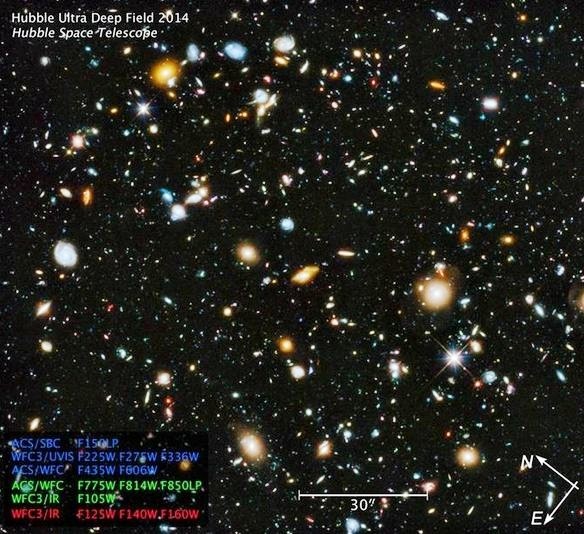Stunning Photo of the Youngest Universe
| Arthur Dominic Villasanta | | Jun 05, 2014 01:54 AM EDT |
NASA photo of the youngest universe ever
NASA has just released an unprecedented image of the deepest of deep space showing the universe at its youngest.
The colorful and comprehensive composite images of deep space shows about 10,000 galaxies that date back to within a few hundred million years of the Big Bang, the cataclysmic event that created the universe and everything that we know of some 14 billion years ago.
Like Us on Facebook
The image shows thousands of galaxies in all ages, sizes and shapes. Some of the oldest galaxies visible on the image appear as light from 12 billion years ago, which is almost as old as the universe itself.
NASA said, however, that the most exciting part of the image is the use of ultraviolet light that reveals the "missing link" of galaxies five billion to 10 billion years old. This is the time span when most stars in the universe came into existence.
The Ultraviolet Coverage of the Hubble Ultra Deep Field study that put the image together has filled in this missing link.
The astounding image was created from 11 year's worth of shots taken by NASA's orbiting Hubble Telescope. The image is the deepest panchromatic image of the sky ever made. One can compare the photo's clarity to seeing one firefly on the moon, said NASA.
Scientists used ultraviolet light to show the full range of colors captured by Hubble. The image provides information from what NASA describes as the "middle ground," or stars made between five billion and 10 billion years ago.
The image was taken in 841 orbits of the Hubble. Many of the 10,000 galaxies in the image are distorted, apparently the victims of collisions with other galaxies. The mutual gravity of these colliding galaxies distorted them into weird shapes quadrillions of kilometers across.
Scientists, however, await an even more astounding series of images. The infrared-friendly James Webb telescope is expected to send back even greater deep-space shots after its launch in 2018. The James Webb telescope will eventually replace Hubble.
TagsNASA, Universe photos, Universe
©2015 Chinatopix All rights reserved. Do not reproduce without permission
EDITOR'S PICKS
-

Did the Trump administration just announce plans for a trade war with ‘hostile’ China and Russia?
-

US Senate passes Taiwan travel bill slammed by China
-

As Yan Sihong’s family grieves, here are other Chinese students who went missing abroad. Some have never been found
-

Beijing blasts Western critics who ‘smear China’ with the term sharp power
-

China Envoy Seeks to Defuse Tensions With U.S. as a Trade War Brews
-

Singapore's Deputy PM Provides Bitcoin Vote of Confidence Amid China's Blanket Bans
-

China warns investors over risks in overseas virtual currency trading
-

Chinese government most trustworthy: survey
-

Kashima Antlers On Course For Back-To-Back Titles
MOST POPULAR
LATEST NEWS
Zhou Yongkang: China's Former Security Chief Sentenced to Life in Prison

China's former Chief of the Ministry of Public Security, Zhou Yongkang, has been given a life sentence after he was found guilty of abusing his office, bribery and deliberately ... Full Article
TRENDING STORY

China Pork Prices Expected to Stabilize As The Supplies Recover

Elephone P9000 Smartphone is now on Sale on Amazon India

There's a Big Chance Cliffhangers Won't Still Be Resolved When Grey's Anatomy Season 13 Returns

Supreme Court Ruled on Samsung vs Apple Dispute for Patent Infringement

Microsoft Surface Pro 5 Rumors and Release Date: What is the Latest?










